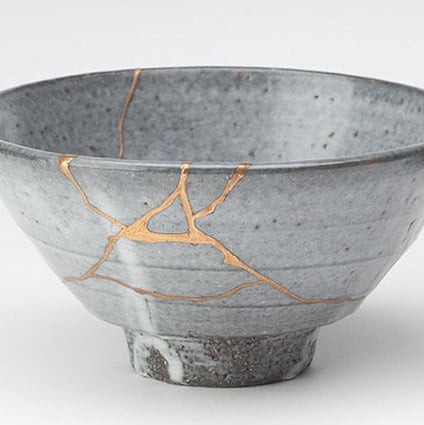Voluntary Vulnerability and Learning the Art of Repair

Tea Bowl fixed in the Kintsuji method
Black Lives Matter
George Floyd, Breonna Taylor, Ahmaud Arbery, Tony McDade, Eric Garner, Freddie Gray, Amadou Diallo… and so many more over 400+ years, far too many to list. There are not enough tears. Saying “I’m sorry” won’t bring you back to your families and loved ones. What can I do to help repair the breakage and begin to heal the self-inflicted wounds of our species to all Black, Indigenous, and People of Color?
I can start by taking this vow offered to me:
I vow to raise my own awareness, to be vigilant against hatred, racism, prejudice, and cruelty in every form, even subtle.
I vow to shine the light of my own insight on hatred, racism, prejudice, and cruelty wherever it may emanate, even within myself.
I vow not to be silent when I witness the horror of my human sisters and brothers, mothers and fathers, and children suffering, even dying under an oppressor’s cruelty.
We can’t change what we can’t talk about, and the subjects that most need addressing, like climate change or poverty or sexual assault or racism, are very hard to discuss, because they make us feel vulnerable or upset. Disagreements become polarized, and we shout as each other, don’t listen or see the good intentions of the other side… The most effective way to prevent polarization is to make yourself vulnerable. I like to imagine it as a verbal form of nonviolence: when you choose to reveal yourself to someone, and you don’t fight back, it disarms the listener. I call this “voluntary vulnerability.”
Stigma silences us from the outside. Shame silences us from the inside… When we dare to reveal our vulnerability, it is both an act of courage and an act of generosity.
~ Anne Hallward interviewed in The Sun, January 2019
••••••••••••••••••••••
Voluntary Vulnerability
It was becoming a mother that truly forced me to begin to break open the internalized prison of shame and learn how to make repairs in my relationships when hurts or tensions arose and a sense of distance was created due to ignorance, misunderstandings or misattunements. When I grew up, the adults around me didn’t know about about the possibility, or vital importance, of making repairs to a hurting relationship. They didn’t know how making a repair helps reestablish a sense of connection and flow between people who care about each other. They had grown up focused on feeling guilty, saying they were sorry, making apologies. Often these were only words and not embodied actions. It wasn’t the repair of understanding and reconnection I so desperately needed. Daniel Siegel helped me begin to learn the language of voluntary vulnerability and repair in his book, Parenting From the Inside Out. I am still learning and practicing daily. It is not easy.
There are now many more people writing and speaking about the necessity of relational repairs and the using the tools of nonviolent communication. None of this is new information but it feels new to people who are just becoming aware of what is possible. Humans are finding better and better language for these things everyday. I want to share an article that was published in Medium by Andrea Mantovani that speaks to just how ancient and powerfully timeless the human need for the art of repair truly is:
KINTSUGI AND THE ART OF REPAIR: life is what makes us
The 400+ year old Japanese art of kintsugi (golden repair) or kintsukuroi (golden joinery) is a pottery repair method that honors the artifact’s unique history by emphasizing, not hiding, the break.
According to art historians, kintsugi came about accidentally (well, it does fit). When the 15th-century shogun Ashikaga Yoshimasa broke his favorite tea bowl, he sent it to China for repairs and was disappointed that it came back stapled together. The metal pins were unsightly, so local craftsmen came up with a solution — they filled the crack with a golden lacquer, making the bowl more unique and valuable. This repair elevated the fallen bowl back to its place as shogun’s favorite and prompted a whole new art form.
An art form born from mottainai — the feeling of regret when something is wasted — and “mushin,” the need to accept change: the cracks are seamed with lacquer resin and powdered gold, silver, or platinum, and often reference natural forms like waterfalls, rivers, or landscapes. This method transforms the artifact into something new, making it more rare, beautiful, and storied than the original.
Why is this art also important for us as humans?
You probably don’t expect other people to be perfect. You may in fact appreciate when people expose their vulnerabilities, show old wounds or admit mistakes. It’s evidence that we’re all fallible, that we heal and grow, that we survive blows to the ego or to our reputations or health and can live to tell the tale. Exposing vulnerabilities, by admitting errors, creates intimacy and trust in relationships, and fosters mutual understanding.
Still, though we’re often relieved when others are truthful, we’re afraid to expose ourselves. We see other people’s honesty about their flaws as positive, but we consider admitting our own failures much more problematic.
This happens because we understand other people’s experiences abstractly, but see our own very concretely. We feel the things that happen to us intimately and physically. On the other hand, what happens to others functions more like an instructive tale, because the pain of failure isn’t our own and the distance gives us perspective. We all understand in theory that bad things can happen. But we also feel really bad when they happen to us, and condemn ourselves.
Vulnerability is courage in you but inadequacy in me: that’s completely wrong. Like the kintsugi crafters who repaired the shogun’s bowl with gold long ago, imperfections are gifts to be worked with, not shames to be hidden.
Turn the ordinary into extraordinary
It’s absurd to be embarrassed about missteps and failures in our lives because they happen to everyone, and no experience is wasted.
Everything you do — good, beautiful, bad, ugly — can serve as a (life) lesson, even if it’s one you would never want to repeat again. Actually, mistakes can be the most important and effective experiences of all. And can be shared truthfully with those in need and that would deserve to learn that wisdom.
Things may fall apart. That’s life. But if you’re wise, you can use every scrap, patch yourself up, and keep going. That’s the essence of resourcefulness, resilience, persistence. It’s mottainai. Some philosophers would argue it actually is the meaning of life.
When we expect everything and everyone to be perfect, including ourselves, we not only discount much of what is beautiful, but we create a cruel world where resources are wasted, people’s positive qualities are overlooked in favor of their flaws, and our standards become impossibly limiting, restrictive, and unhealthy.
The kintsugi approach instead makes the most of what already is, highlights the beauty of what we do have, flaws and all, rather than leaving us eternally grasping for more, different, other, better.
In other words, the experiences you have, and the person you already are, suffice. You may occasionally chip and break and need repairs. And that’s fine. But reality is the best and most abundant material on the planet, available to anyone, comes for free, and we can all use what we already have — including our flaws — to be even more beautiful.
After all, our cracks are what give us character. And let us shine!
~ First published in Medium by Andrea Mantovani

